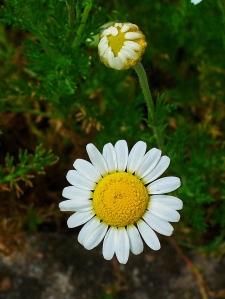[An Archaeologist’s Guide to British Species] #88: Chamomile
In 2024, I am continuing to blog an A-Z compendium of human interactions with species in the British landscape. A list of references for information used in this series can be found here. An index of species covered so far can be found here.

Common chamomile (Chamaemelum nobile) H. Zell – Own work, CC BY-SA 3.0, https://commons.wikimedia.org/w/index.php?curid=9482809
Chamomile
Also known as camomile
There are three native species of chamomile, all of which have white daisy-like flowers with yellow centres, finely divided feathery leaves and a strong aroma. Corn chamomile (Anthemis arvensis) which flowers May – July has a sweet scent, while stinking chamomile (A. cotula) flowers July- September and has more of a rank scent. Both commonly occur on arable land. Stinking chamomile is especially associated with heavy clay soils, and the presence of its seeds among charred cereal remains from archaeological sites has been used to infer agriculture on such soils. Its seeds can also remain dormant in the soil for a long time. Lawn chamomile or common chamomile (Chamaemelum nobile) is a fragrant low-growing perennial which grows in grassland and on sandy commons in southern England and south-west Ireland, and which flowers from July – August. The name chamomile derives from the Greek χαμαίμηλον, khamaimēlon, meaning ground apple, on account of the apple-like scent.
Common chamomile flowerheads make a herbal tea. They are picked when the petals start to turn down and then dried until papery. The plant is commonly recognised as a relaxant, although chamomile tea has also been used to treat coughs and colds.